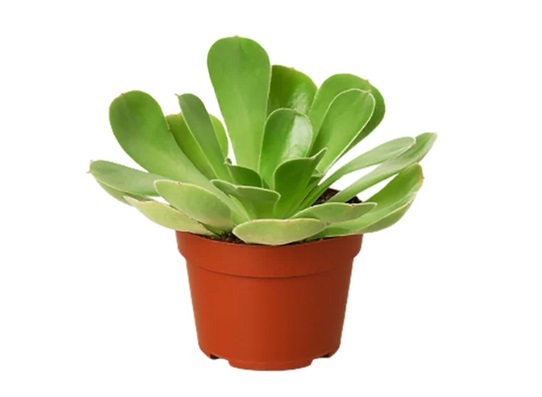Succulents tend to have roots that are more shallow and slower growing than other houseplants. Aeoniums can grow happily in a pot for many years without the need to repot into a larger container. The thick fleshy leaves hold all of the moisture necessary for these succulents making the root system more just a structure to anchor the plant in the soil. Top heavy tree type Aeonium may need support to keep them upright and benefit greatly from being planted in shallow pots with a wide base for stability.
Often these types of pots are called bulb, azalea, or alpine pots. Terra cotta or other clay pots are ideal for planting Aeonium in as it is very porous, allowing the soil to dry fully between waterings. Plastic containers can be used for growing Aeonium as long as the pot has sufficient drainage at the bottom and the planting medium is very well draining.

Potting Aeonium
- When planting Aeonium in containers the size of the container is important.
- Choose a pot that is only one or two sizes larger as Aeonium likes to grow in close quarters. This will also provide a certain amount of stability for plants that have branching top growth.
- Gently remove the plant from its current pot, being careful to disturb the root ball as little as possible.
- Fill the bottom ⅓ of the new pot with potting mix that has been premoistened.
- Place your Aeonium at the same level it was growing in the previous container or slightly lower to give the plant more stability.
- Fill in around the root ball with the potting mix and gently firm it in so that the plant is stable.
- Use a thin mulch of sharp sand or fine, washed gravel on the top of the soil. This prevents soil from splashing onto the plant when it is watered.

Repotting Aeonium
The most common reason to repot Aeonium is that the potting mix is failing and not draining properly. Potting mix that contains peat moss will retain moisture longer than Aeoniums need, leading to roots that are more likely to contract root rot. Changing the pot and repotting with a fresh growing medium typically will refresh the plant enough and encourage healthy growth.
Aeonium that has become root-bound will begin to show signs by growing aerial roots along the stems in order to attract moisture from the air. This is a great time to increase the size of your pot by one or two steps and refresh the plant with a new potting mix. This is also a good time for taking stem cuttings to propagate new plants.
Best Soil For Aeonium
A quick-draining potting mix is recommended for all succulents. This could be an all-purpose, peat-free houseplant mix that has perlite, sharp sand, or pumice added for extra drainage. Potting mixes specifically blended for succulents and cacti are also excellent and easy to find at most garden centers or nurseries. Choose a peat-free mix to ensure that the medium will fully dry between waterings.
A homemade potting mix can be made from 1 part organic compost (as weed-free as possible), 2 parts coconut coir, and 1 part sharp sand, perlite, vermiculite, or pumice grit. This DIY mix is the economical way to go if you have many plants to repot or propagate and can be kept in a water-tight container for a long period.
Aeonium Drainage
Excellent drainage is the key to keeping Aeonium healthy. The root system needs a period of drying between waterings so choose a pot that has plenty of drainage holes at the bottom and ideally is made from a breathable material such as terra cotta. Using a saucer under the pot helps to protect furniture and rugs and always need to be emptied after a watering session.
To keep the plant from sitting in soggy soil for too long. Decorative pots that have no drainage can still be used as a cache pot to hold the Aeonium planted in another plastic nursery pot that fits inside. Remember that the cache pot will also need to be emptied after watering sessions like a shallow saucer.
Sources: “Aeonium” University of Wisconsin at Madison, www.hort.extension.wisc.edu
